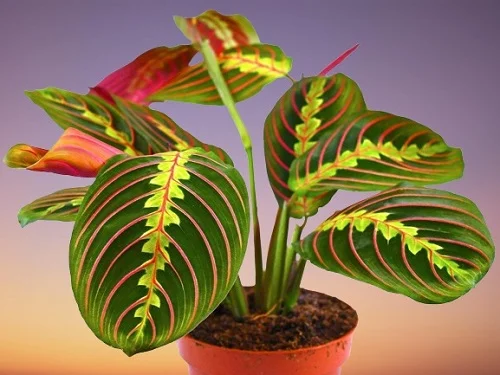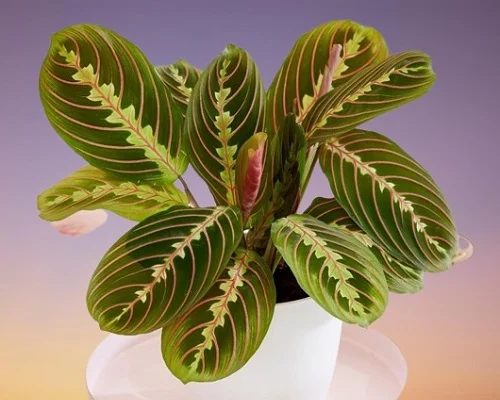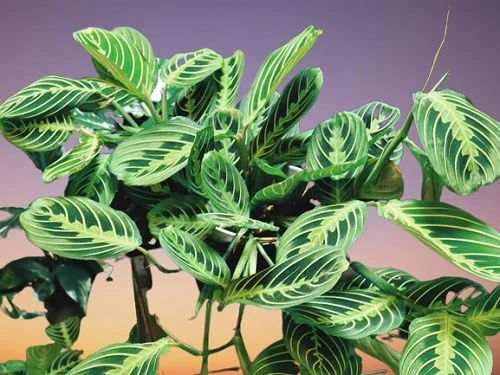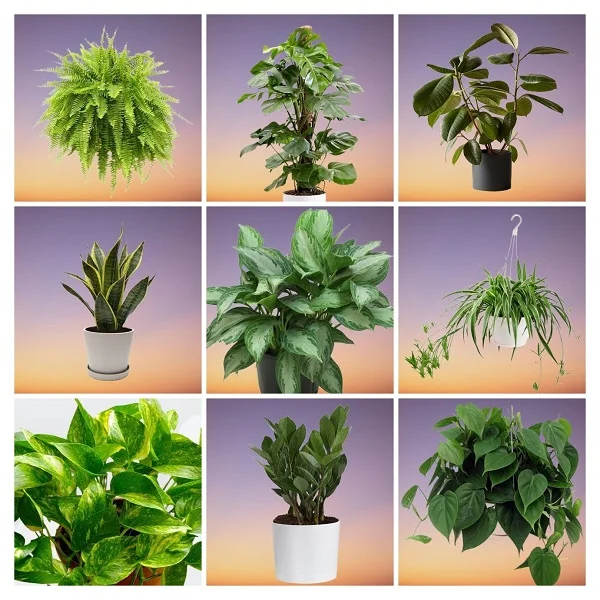How to Grow and Care for Maranta Plant (Maranta leuconeura) Indoors
Some links in this post may be affiliate links
Maranta Plants blossom in partial light, a warm and humid enviroment and consistently moist, rich, well-drained, all purpose soil coupled with monthly feeding in the growing season.
Maranta leuconeura are low growing plants with long leaves known for their curious habit of folding and raising at night and hence their common name, 'Prayer Plants'.
With their uniquely colored and patterned leaves, Maranta are an excellent addition to any plant collection. They are some of the popular tropical foliage plants for a magnificent splash of color in any space.

Botanical name: Maranta leuconeura
Family: Marantaceae
Common name: Maranta Plant, Prayer Plant
Origin
Maranta are native to tropical Central and South America and the West Indies. Maranta are named for Bartolomeo Maranta, an Italian physician and botanist of the 16th century.
Size
Maranta are low-growing plants which rarely exceed the height of 8 inches The leaves are about 6 inches long. These characteristics make Maranta perfect for growing in limited spaces.
On account of their compact size and high requirement for warm and humid conditions, Maranta Plants are some of the best plants for a closed terrarium where these conditions can be maintained.
Varieties
Many varieties and cultivars of Maranta are available. Some of the common ones include Maranta tricolor commonly called Herringbone Plant whose leaves bear prominent red veins.
Other common varieties include Maranta leuconeura kerchoveana commonly called Rabbit's Tracks whose leaves bear brown blotches which turn green with age and Maranta leuconeura massangeana whose leaves are blackish green with silvery veins among others.
Toxicity
Maranta Plants (Maranta leuconeura) are non-toxic to both humans and pets as indicated by ASPCA. They are safe to grow indoors.
Related Plants
Maranta are closely related to the Calathea, Ctenanthe and Stromanthe. These groups of plants are sometimes commonly called Prayer Plants in reference to their curious characteristic of closing their leaves at night.
Where to Buy
Maranta are a beautiful plants to add to your collection. You may acquire these plants online from Etsy (Link to Etsy) or from Amazon (Link to Amazon).
Maranta leuconeura Care Indoors
Maranta Plants blossom in partial light, average warmth of 16-280C, humidity of 60-80% and consistently moist, fertile, well-drained, all purpose soil coupled with monthly feeding during the growing season.
Maranta leuconeura requires regular pruning to keep it neat as well as rejuvenate growth. Repotting is needed every 2 years to keep the plant thriving. Keep reading for more on these growing conditions and how to achieve them.

Light requirements
Maranta grow best in partial light as colors fade in bright light. Too little light will cause the leaves to close like they do at night. Keep the plant away from direct sunlight as it can lead to sunburn on leaves.
Maranta can also be grown under grow lights where natural light is inadequate. Take a look at these full spectrum grow lights on Amazon.
Regularly rotate the pot to ensure that the plant receives light on all sides for uniform growth and also avoid leggy growth.
Watering
Water Maranta thoroughly during the growing season while allowing the top 1-2 inches of soil to dry out between waterings to keep the soil moist at all times.
Decrease watering in the cold season as growth is minimal at this time but do not allow the soil to dry out completely.
Being a tropical plant, water the plant with water that is at room temperature to avoid shocking the plant which can result in reduced growth.
Maranta Plants are sensitive to chemicals dissolved in water, therefore, water Maranta with water that is free of chlorine and flourides.
Ensure the pot has a drainage hole to prevent the soil from getting soggy as it can lead to root-rot and eventual death of the plant. Avoid wetting the foliage during watering or water from the bottom instead to prevent fungal infestation.
Temperature and Humidity
Maranta prefer average warmth of 16-280C. Protect it from cold drafts and sudden changes in temperature as they can cause leaf drop.
Maranta require high humidity of 60-80% to thrive. To increase humidity, set the pot on a wet pebble tray or use a cool mist humidifier. You may also grow the plant in a terrarium as a high humidity can be maintained inside a terrarium.
Maranta can also be grown in a well-lit bathroom and other moist areas which remain constantly humid. Learn more on how to raise humidity for houseplants.
Clean the leaves regularly by damp-wiping with a soft cloth to keep them clean and neat as well as discourage pest and disease infestation.
Fertilizer
Feed Maranta with a balanced, water-soluble fertilizer once monthly through out the growing season to promote a lush growth. Withhold feeding in the cold season as growth is minimal and feeding at this time can lead to fertilizer burn and death of the plant.
Potting Medium
The best potting soil for Maranta should be rich in organic matter and free-draining to prevent it from getting soggy while providing the required nutrients. Most all purpose potting mixes are ideal for this plant.
Repotting
Repot Maranta every 2 years at the beginning of the growing season. Use a pot with a drainage hole and free-draining soil that is rich in organic matter.
Marantas do not like to sit in soggy soil, therefore, ensure the soil is free-draining and the pot has a drainage hole as soggy soil can lead to root-rot.
You may divide the large plants at the time of repotting and use the splits to propagate new plants. Check out these pots with drainage holes on Amazon.
Pruning
Pruning Maranta involves removal of dead and yellow foliage to maintain the plant neat and attractive. Cutback the stems at the beginning of the growing season to rejuvenate growth.
Propagation
Maranta leuconeura propagation can be done at the beginning of the growing season by plant division or from stem-tip cuttings.
How to propagate Maranta by plant division
Take the Maranta Plant out of its pot and divide it into several sections. Ensure each section has some roots inorder to hasten rooting.
Pot the sections into individual pots in moist, free-draining soil. Ensure the pots have a drainage hole to prevent the soil from getting soggy as it can lead to rotting
Cover the pots with clear polythene to create a greenhouse effect and maintain warm humid conditions which hasten establishment.
Place the pots in a warm, brightly-lit place away from direct sunlight until new growth has emerged in the sections.
Gradually remove the polythene cover over a period of two weeks to acclimatize the new plants.
Then move the set up to a warm, well-lit place and maintain the soil moist until the new Maranta Plants are well established after which routine care can begin.
How to propagate Maranta from stem-tip cuttings in soil
Take a stem-tip cuttings from a healthy Maranta Plant by cutting the stem just below a leaf node. Dip the cut end of the cutting in a rooting hormone to hasten rooting and insert the cutting in moist, rooting soil.
Place the set up in warm, semi-shaded place and maintain the soil moist through out until new growth emerges.
Allow the new Maranta Plants to be well established before transplanting after which routine care can begin.
How to propagate Maranta from stem-tip cuttings in water
Maranta stem-tip cutting can also be rooted in water. Take a stem-tip cuttings from a healthy Maranta Plant by cutting the stem just below a leaf node.
Dip the cut end of the cutting in rooting hormone and place the cutting in a glass jar of plain water.
Place the set up in a well-lit spot and change the water at least every 5-7 days.
When the roots are about 2 inches long, gradually add soil into the water to acclimatize the cutting roots to growing in soil.
When the roots are about 4 inches long, the cuttings can be potted into individual pots.
Keep the soil moist and mist the plant regularly until new growth emerges.
Allow the new Maranta Plants to be well established before transplanting.

Maranta leuconeura Problems
Maranta leuconeura problems include dropping leaves, brown leaf tips, leaf spots, yellowing, stunted growth, rotting, pests and diseases among others. Keep reading for more details on these problems and how to fix them.
Pests
Common pests in Maranta are mealy bugs, aphids, scale insects and spider mites. Isolate the affected plant to prevent spread to the other plants and treat it for the pests. Check out this guide on how to identify and get rid of houseplants pests.
Diseases
Maranta is prone to leaf spot due to the humid conditions that it prefers. Isolate the affected plant to prevent spread to the other plants and treat it appropriately for the leaf spot disease.
Curled, spotted leaves and yellowing lower leaves
Maranta curled, spotted leaves and lower leaves yellowing are due to underwatering. Water the plant liberally and keep the soil consistently moist at all times during the growing season. Keep the soil slightly moist in the cold season but do not let the soil dry out completely. Read more on how to water houseplants the right way.
Dropping leaves
Maranta dropping leaves is due to too dry air (low humidity). These plants are very sensitive to low air humidity. Set the pot on a wet pebble tray or use a cool mist humidifier to raise humidity.
Maranta can also be grown in a closed terrarium as a high humidity can be maintained in a terrarium. In addition, you may grow Maranta in a well-lit bathroom, kitchen and other moist areas in the home where it can enjoy the constantly humid conditions.
Limp and rotting stems
Maranta limp and rotting stems are due to too cold air and or too wet soil. At this point, the plant may be too far gone to be saved.
To prevent limp and rotting stems in the future, maintain an average warmth of 16-280C. Keep the plant away from cold drafts and sudden changes in temperature. Also, avoid soggy soil by ensuring that the pot has a drainage hole and that the soil is free-draining.
Brown, dry leaf tips, stunted growth
Maranta brown and dry leaf tips accompanied by stunted growth are an indication of spider mite infestation due to the air being too dry. Remove the dead growth and set the pot on a wet pebble tray to raise humidity or grow the plant in the humid areas of the home like the bathroom if the lighting is adequate.
Discolored or scorched leaves
Maranta discolored or scorched leaves are due to exposure of the plant to direct sunlight. Move the plant to a shaded spot or protect it from direct sunlight to prevent its death.
You liked it? Share on social media.
Related Content
Amazon Associates Disclosure
Homeplantsguide.com is a participant in the Amazon Services LLC Associates Program, an affiliate advertising program designed to provide a means for sites to earn advertising fees by advertising and linking to amazon.com.





